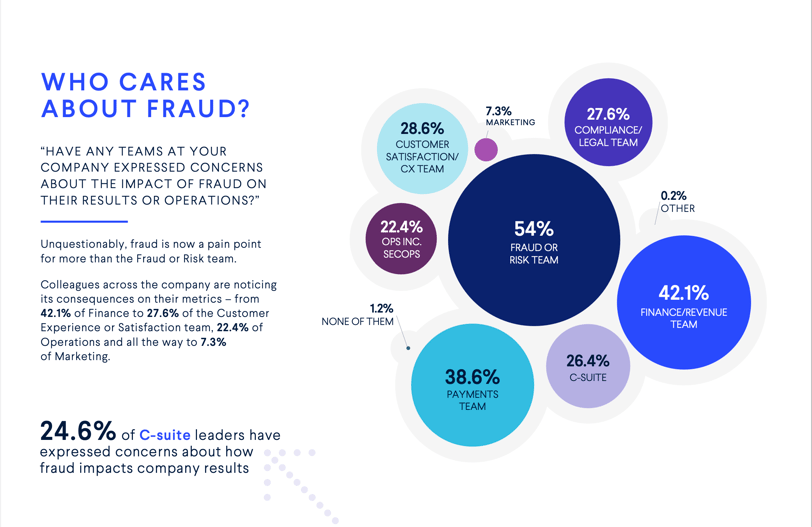Global Fraud Trends 2024
Key Findings and Recommendations
8/28/20242 min read


The 2024 Fraud and Payments Survey by Ravelin highlights the evolving landscape of fraud, revealing significant impacts on businesses worldwide. This comprehensive survey provides insights into the consequences of fraud, emerging trends, and strategies to combat these challenges.
Key Findings
Impact on Growth and Revenue: Fraud significantly hinders business growth, with 52% of companies reporting stifled growth due to fraudulent activities. Revenue loss is a major concern, with 27% of firms losing over $15 million annually to fraud.
Reputational Damage: Fraud not only affects financial metrics but also damages brand reputation. Over 60% of companies have been featured in the media due to fraud, leading to negative perceptions and customer churn.
Emerging Fraud Trends: The survey identifies a rise in AI-powered fraud, with 64% of participants experiencing such attacks. Payment fraud, account takeovers, and chargeback fraud are among the top concerns, with payment fraud affecting 69% of companies.
Sector-Specific Challenges: Different industries face unique fraud challenges. For instance, the travel and digital goods sectors are heavily impacted by customer satisfaction issues due to fraud, while marketplaces struggle with operational costs related to disputes and account recovery.
Tools and Strategies: Machine learning and two-factor authentication (2FA) are highlighted as practical tools against fraud. However, budget constraints and concerns about customer friction remain significant barriers to implementing robust anti-fraud measures.
Key Recommendations
Leverage Advanced Technologies:
AI and Machine Learning: Utilize AI-driven solutions for real-time fraud detection and prevention. These technologies can identify patterns and anomalies that traditional methods may miss.
Behavioral Analytics: Implement behavioral analytics to monitor user interactions and detect unusual activities that may indicate fraud.
Strengthen Authentication Measures:
Multi-Factor Authentication (MFA): Enhance security by requiring multiple forms of verification, making it more difficult for fraudsters to gain unauthorized access.
Biometric Verification: Use biometric data for identity verification to add an extra layer of security.
Enhance Transaction Monitoring:
Real-Time Monitoring: Implement systems that provide real-time monitoring of transactions to identify and respond to suspicious activities quickly.
Advanced Fraud Detection Tools: Employ tools that flag and verify potentially fraudulent transactions, such as requiring CVV values for card payments.
Educate and Train Employees:
Regular Training Programs: Conduct regular training sessions to keep employees informed about the latest fraud tactics and prevention strategies.
Leadership Involvement: Ensure that leadership is involved in training and modeling ethical behavior, reinforcing the importance of fraud prevention across all levels of the organization.
Develop a Comprehensive Fraud Prevention Program:
Written Policies and Procedures: Establish clear, well-documented fraud prevention policies and procedures to guide organizational efforts.
Internal Audits and Compliance: Regularly audit and update fraud prevention measures to adapt to new threats and ensure compliance with relevant regulations.
Foster Cross-Industry Collaboration:
Information Sharing: Participate in industry forums and networks to share information about fraud trends and prevention strategies.
Partnerships with Payment Providers: Collaborate with payment service providers to enhance security measures and prevent fraud.
By adopting these strategies, businesses can better protect themselves against the growing threat of fraud, ensuring both financial security and customer trust. As fraudsters evolve their tactics, staying informed and proactive is crucial for effective fraud prevention.
A shift in mindset: Stop viewing fraud prevention solely as a part of customer care. Even though it involves customer interactions, prevention heavily relies on data analysis and creating strategies to impact the customer journey, sales, finance, and customer care.
The fraud prevention department or team is not just a cost for the company. It can help save money and increase sales volumes by taking more calculated risks, creating a positive reputational impact, and providing a more seamless experience than the competition.Please contact us at contact@quarenta.se if you'd like to discuss how we can assist you.
source: RAVELIN GLOBAL FRAUD TRENDS 2024
CONTACT US
contact@quarenta.se


